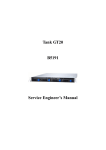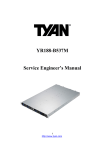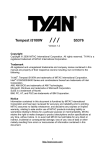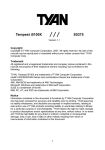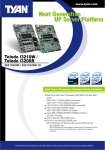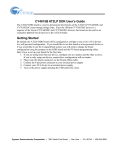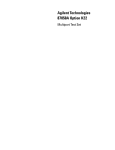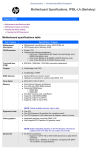Download Tyan B5211G20V4H server barebone
Transcript
Tank GT20 B5211 Service Engineer’s Manual Table of Contents Chapter 1: Overview 1.1 About the Tank GT20 B5211…………………….……...…………… 1 1.2 Product Models…………………..……………………….………....... 1 1.3 Features……………………………………………………………….. 2 1.4 Standard Parts List……………….…….……..………......................... 4 1.4.1 Box Contents……………………...……………………………. 4 1.4.2 Accessories…………………………………………………….. 5 1.5 Optional Parts………………………………………………………… 7 1.6 About the Product……….………………………..……....................... 8 1.6.1 System Front View…………………………..…………………. 8 1.6.2 System Rear View………………………………….................... 8 1.6.3 LED Definitions………………………………………………... 9 1.6.4 Motherboard Layout…………………………............................. 11 1.6.5 Jumpers & Connectors……………………………………......... 12 1.6.6 System Block Diagram……......................................................... 13 1.6.7 Internal View…………………………………………………… 14 Chapter 2: Setting Up 2.0.1 Before You Begin………..…………………………................... 2.0.2 Work Area…………………………………………………….... 2.0.3 Tools …………….……………………....................................... 2.0.4 Precautions …………………………………………………...... 2.1 Installing Motherboard Components...………………..………............ 2.1.1 Removing the Chassis Cover…………………………………... 2.1.2 Installing the CPU, Heatsink and Air Duct…………………….. 2.1.3 Installing the Memory……………..…………………………… 2.1.4 Installing the Expansion Card.…………………………………. 2.1.5 Installing the Hard Drive……………………………………….. 2.2 Rack Mounting………………….......................................................... 2.2.1 Installing the Server in a Rack………………............................. 2.2.2 Rack Mount Instructions…………………….............................. 15 15 15 16 17 17 18 21 22 23 25 25 29 Chapter 3: Replacing Pre-Installed Components 3.1 Introduction…………………………………………………………… 3.1.1 Work Area…………………………………………………….... 3.1.2 Tools…………………………………………….………............ 3.1.3 Precautions……………………………………………………... 31 31 31 32 i 3.2 Disassembly Flowchart…………………………..…………………… 3.3 Removing the Cover……………………………..…….……………... 3.4 Replacing Motherboard Components……………..………………….. 3.4.1 Disconnecting All Motherboard Cables…………………........... 3.4.2 Removing the Motherboard…………………………………….. 3.5 Replacing the Slim DVD-ROM……..…………………....................... 3.6 Replacing the LED Control Board..…………………………………... 3.6.1 M1003 LED Control Board Features…………………............... 3.6.2 M1003 LED Control Board Connector Pin Definition..……...... 3.7 Replacing the M1012 Adapter Board…………………………............ 3.7.1 M1012 Adapter Board Features………….…………………...... 3.7.2 M1012 Adapter Board Connector Pin Definitions……………... 3.8 Replacing the SATA Backplane (M1208-3-SN)…...…………............ 3.8.1 SATA Backplane (M1208-3-SN) Features…………………….. 3.9 Replacing the System Fan…...…..…………........................................ 3.10 Replacing the Power Supply..…..…………........................................ Appendix I: BIOS Differences Appendix II: Cable Connection Tables Appendix III: Installing SMDC Cards Appendix IV: FRU Parts Table ii 33 34 35 35 36 37 39 40 41 42 44 45 50 51 53 54 PREFACE Copyright This publication, including all photographs, illustrations, and software, is protected under international copyright laws, with all rights reserved. Neither this manual, nor any material contained herein, may be reproduced without written consent of manufacturer. Copyright 2007 Version 1.00 Disclaimer Information contained in this document is furnished by TYAN Computer Corporation and has been reviewed for accuracy and reliability prior to printing. TYAN assumes no liability whatsoever, and disclaims any express or implied warranty, relating to sale and/or use of TYAN products including liability or warranties relating to fitness for a particular purpose or merchantability. TYAN retains the right to make changes to product descriptions and/or specifications at any time, without notice. In no event will TYAN be held liable for any direct or indirect, incidental or consequential damage, loss of use, loss of data or other malady resulting from errors or inaccuracies of information contained in this document. Trademark Recognition All registered and unregistered trademarks and company names contained in this manual are property of their respective owners including, but not limited to the following. TYAN and Tank GT20 B5211 are trademarks of TYAN Computer Corporation. Intel, Xeon, and combinations thereof are trademarks of Intel Corporation. Phoenix, PhoenixBIOS, and combinations thereof are trademarks of Phoenix Technologies. Microsoft Windows is a trademark of Microsoft Corporation. IBM, PC, AT, PS/2 are trademarks of IBM Corporation. InfiniBand is a trademark of Mellanox Technologies. Winbond is a trademark of Winbond Electronics Corporation. Portable Document Format (PDF) is a trademark of Adobe Corporation. iii Federal Communication Commission (FCC) Notice for the USA Compliance Information Statement (Declaration of Conformity Procedure) DoC FCC Part 15: This device complies with part 15 of the FCC Rules Operation is subject to the following conditions: 1) This device may not cause harmful interference; 2) This device must accept any interference received including interference that may cause undesired operation. If this equipment does cause harmful interference to radio or television reception, which can be determined by turning the equipment off and on, the user is encouraged to try one or more of the following measures: – Reorient or relocate the receiving antenna. – Increase the separation between the equipment and the receiver. – Plug the equipment into an outlet on a circuit different from that of the receiver. Consult the dealer on an experienced radio/television technician for help. Notice for Canada This apparatus complies with the Class B limits for radio interference as specified in the Canadian Department of Communications Radio Interference Regulations. (Cet appareil est conforme aux norms de Classe B d’interference radio tel que specifie par le Ministere Canadien des Communications dans les reglements d’ineteference radio.) Notice for Europe (CE Mark) This product is in conformity with the Council Directive 89/336/EEC, 92/31/EEC (EMC). CAUTION: Lithium battery included with this board. Do not puncture, mutilate, or dispose of battery in fire. Danger of explosion if battery is incorrectly replaced. Replace only with the same or equivalent type recommended by manufacturer. Dispose of used battery according to manufacturer instructions and in accordance with your local regulations. iv About this Manual This manual provides you with instructions on installing your Tank GT20. This Manual is intended for experienced users and integrators with hardware knowledge of personal computers. This manual consists of the following parts: Chapter1: Provides an introduction to the GT20 B5211 barebones, packing list, describes the external components, gives a table of key component, and provides block diagrams of the system. Chapter2: Covers procedures on installing the CPU, memory modules, PCI-E card and hard drives. Chapter3: Covers removal and replacement procedures for pre-installed components. Appendix I: BIOS Differences Appendix II: Cable Connection Tables Appendix III: Installing SMDC Cards Appendix IV: FRU Parts Table v SAFETY INFORMATION Before installing and using the Tank GT20, take note of the following precautions: – – – – – – – – – – – – vi Read all instructions carefully. Do not place the unit on an unstable surface, cart, or stand. Do not block the slots and opening on the unit, which are provided for ventilation. Only use the power source indicated on the marking label. If you are not sure, contact the power company. The unit uses a three-wire ground cable, which is equipped with a third pin to ground the unit and prevent electric shock. Do not defeat the purpose of this pin. If you outlet does not support this kind of plug, contact your electrician to replace your obsolete outlet. Do not place anything on the power cord. Place the power cord where it will not be in the way of foot traffic. Follow all warnings and cautions in this manual and on the unit case. Do not push objects in the ventilation slots as they may touch high voltage components and result in shock and damage to the components. When replacing parts, ensure that you use parts specified by the manufacturer. When service or repairs have been done, perform routine safety checks to verify that the system is operating correctly. Avoid using the system near water, in direct sunlight, or near a heating device. Cover the unit when not in use. Chapter 1: Overview 1.1 About the Tank GT20 B5211 Congratulations on your purchase of the TYAN Tank GT20 B5211, a highly-optimized rack-mountable barebone system. The Tank GT20 B5211 is designed to support Intel® Kentsfield/Yorkfield/Conroe/Wolfdale processors, providing a rich feature set and incredible performance. Leveraging advanced technology from Intel, the Tank GT20 B5211 server system is capable of offering scalable 32 and 64-bit computing, high-bandwidth memory design, and a lightning-fast PCI-E bus/PCI-X slot and Tyan IPMI SMDC implementation. The Tank GT20 B5211 not only empowers your company in today’s demanding IT environment but also offers a smooth path for future application usage. TYAN is also proud to deliver the Tank GT20 B5211 in SATAII flavor while supporting up to four hot-swappable SASA HDD, one slim DVD-ROM. The Tank GT20 B5211 uses TYAN’s latest tooling-made chassis featuring a robust structure, tool-less and modularized design, and a solid mechanical enclosure. All of this provides the Tank GT20 B5211 the power and flexibility to meet the needs of nearly any server application. 1.2 Product Models Model Supported HDD type & quantity Hot-swappable Power supply B5211G25V4H SATAII (4) Yes 400W single Chapter 1: Overview 1 1.3 Features Enclosure • Industry 19” rack-mountable 1U chassis • Dimension: D 22.4 x W 17.2 x H1.72 inch (568 x 436 x 43.6mm) Processors • Single LGA775 socket • Support Intel® Kentsfield/Yorkfield /Conroe/Wolfdale processors (lower than 105W) • 1333/1066/800 FSB supported Chipset • Intel Bigby-V MCH • ICH9R south bridge • SMSC SCH5027 super I/O chip • EZ-USB AT2 (CY7C68300C) Ultra ATA controller Memory • (4) 240-pin DDR2 DIMM sockets • Maximum of 8GB DDR2-667/800 • Supports Un-buffered ECC/non-ECC DIMMs Expansion Slots • (1) PCI-E x16 slot with PCI-E x8 bus Via M2083-RS (support full profile PCI-E card w/o SMDC) or (1) PCI-X slot via M2061 (option) • (1) 200 pin vertical SO-DIMM for optional Tyan IPMI SMDC Back I/O Ports • Stacked PS/2 mouse & keyboard ports • Stacked (2) USB 2.0 ports and (RJ45 port for OPMA • (1) 15-pin VGA port • (1) 9-pin COM port • side-by-side RJ45 10/100/1000 2 Front Panel Features • I/O – (2) USB2.0 ports • LED indicators – Power LED – (2) LAN LEDs – HDD active LEDs –ID LED –Warning LED • Switches – Power – Reset – NMI – ID Integrated Storage Controller • Support (6) SATA II ports running at 3Gbps • Single Ultra ATA Channels(from CY7C68300C) for Single ATA devices Storage • Support (4) hot-wrapped SATA HDD with RAID 0, 1, 5 and 10 support for Windows only • Pre-installed (1) slim type DVD-ROM Networking • (2) Intel i82573 GbE NICs ( 1*82573V+1*82573L) Video • XGI Z9S • 32MB DDR2 frame buffer memory Motherboard • TYAN Toledo i3200R S5211 system board • ATX footprint (12” x 9.6”) (305 x244m) Chapter 1: Overview ports BIOS ® • Phoenix on 8Mbit LPC Flash ROM • Serial Console Redirect • USB boot supported • Supports ACPI • PnP, DMI2.0, WfM2.0 power management • S0/S1/S4/S5 states supported Sever Management • Auto fan control • Chassis intrusion header • Temperature, voltage, and fan monitoring • Tyan SMDC M3295-2, M3296 IPMI v2.0 compliant Remote sever management kit (option ) Chapter 1: Overview System Cooling • (2) 40*40*28mm heavy-duty fans • (2) 40*40*56mm heavy-duty fans • (1) passive CPU heatsink Power Supply • 12V, 400W 80+ plus • Universal 24-pin + 8-pin + 4-pin power connectors Regulatory • FCC Class A (Declaration of Conformity) • CE (Declaration of Conformity) Environment Temperature • Operating temperature: 5°C ~ 35°C • Non-operating temperature: -40°C ~ 70°C 3 1.4 Standard Parts List This section describes the Tank GT20 B5211 package contents and accessories. Open the box carefully and ensure that all components are present and undamaged. The product should arrive packaged as illustrated below. 1.4.1 Box Contents Component Description TYAN S5211G2NR-1U Motherboard GT20 1U chassis, (4) hot-swap HDD bays 400W Single Power (2) System fans (40mm x 40mm x 56mm) (2) System fans (40mm x 40mm x 28mm) 1 x Air Duct 1 x slim DVD-ROM drive 4 Chapter 1: Overview 1.4.2 Accessories If any items are missing or appear damaged, contract your retailer or browse to TYAN’s website for service:http://www.tyan.com The Web site also provides information on other TYAN products, plus FAQs, compatibility lists, BIOS settings, and more. 1 x Tyan Motherboard Drive CD 1 x Heatsink HDD Screws Power Cables Left to right: Europe, US Mounting Ears & Screws Barebone Manual & Mainboard Manual Chapter 1: Overview 5 Rail Kit Rear Front 4 x Mounting Bracket Screws Kit 6 Sliding Brackets 2 x Front L-Bracket 2 x Rear L-Bracket 2 x Sliding Rails Chapter 1: Overview 1.5 Optional Parts Item Model Number Picture Quantity Description CLCM-0040 1 LCD Module Kit for GT Series 1U Chassis M3295-2 1 SMDC Card M3296 1 M2061 Riser Card M2061 1 TF-PCI-E to PCI-X 1U Riser Card Chassis Front Bezel CFBZ-0070 1 Front Bezel for GT Series 1U Chassis LCD Module IPMI M2 SMDC IPMI Card Chapter 1: Overview SMDC IPMI M2 Card 7 1.6 About the product The following views show you the product. 1.6.1 System Front View 1.6.2 System Rear View Power Supply Socket PS/2 Mouse/ Keyboard Ports LAN Port (NIC3) PCI-E Slot ID LED LAN Port (NIC1) USB Port x 2 Serial Port 8 LAN Port (NIC2) VGA Port Chapter 1: Overview 1.6.3 LED Definitions Front Panel LED Color State Description Power Green OFF OFF OFF ON Power OFF HDD Activity Amber OFF Blinking OFF HDD/DVD access activity No disk activity LAN1/LAN2 Linkage Green Green OFF ON Blinking OFF Linked to LAN Accessing LAN No LAN link Warning Red OFF ON OFF Fan failure & system intrusion Normal ID LED Blue OFF ON OFF System is identified System is not identified Hot Swappable HDD fail LED Amber OFF ON OFF HDD fail No failure found Hot Swappable HDD Power/Access LED Green Green OFF ON Blinking OFF HDD ready HDD access activity No disk activity Chapter 1: Overview 9 Rear I/O LED LED Color State Description RJ45 NIC1 Linkage (Left Side) Green Green OFF ON Blinking OFF Linked to LAN Accessing LAN No LAN link RJ45 NIC1 Mode (Right Side) Yellow Green OFF ON ON OFF Gigabit mode 100M mode 10M mode RJ45 NIC2 Linkage (Left Side) Green Green OFF ON Blinking OFF Linked to LAN Accessing LAN No LAN link RJ45 NIC2 Mode (Right Side) Yellow Green OFF ON ON OFF Gigabit mode 100M mode 10M mode RJ45 for SMDC Linkage (Left Side) Green OFF Blinking OFF Accessing SMDC No SMDC link RJ45 for SMDC Mode (Right Side) Green OFF ON OFF Linked to SMDC No SMDC link ID LED Blue OFF ON OFF System identified System not identified NOTE:”Right” or ”Left” is viewed from the rear. 10 Chapter 1: Overview 1.6.4 Motherboard Layout Chapter 1: Overview 11 1.6.5 Jumpers & Connectors Jumper/Connector COM2 (J19) FAN1/2/3/4/5/6 USB1 (JP7) / USB2 (JP2) TYFP1 (JP9) TYFP2 (J22) J23 COM2 Header 4-pin Fan Connector USB Front Panel Connector 18-pin Front Panel Connector 12-pin Front Panel Connector (reserved for OEM only) LCM Connector (reserved for OEM only) IPMB (J4) IPMB Connector J11 IPMI Connector J10 Riser Power Connector J24 Barebone Fan Connector (reserved for OEM only) JP4 PCI-X Speed Select Jumper CMOS (JP3) 12 Function Clear CMOS Jumper Chapter 1: Overview 1.6.6 System Block Diagram Chapter 1: Overview 13 1.6.7 Internal View 1. Power Supply 5. System Fans 2. PCI-E slot 6. M1210 3. Memory Slots 7. Four SATA/SAS HDD Bays 4. CPU Sockets 8. M2083 (under the Air Duct) 14 Chapter 1: Overview Chapter 2: Setting Up 2.0.1 Before you Begin This chapter explains how to install the CPU, CPU heatsink, memory modules, and hard drives. Instructions on inserting a PCI-E card are also given. Take note of the precautions mentioned in this section when installing your system. 2.0.2 Work Area Make sure you have a stable, clean working environment. Dust and dirt can get into components and cause malfunctions. Use containers to keep small components separated. Putting all small components in separate containers prevents them from becoming lost. Adequate lighting and proper tools can prevent you from accidentally damaging the internal components. 2.0.3 Tools The following procedures require only a few tools, including the following: z A cross head (Phillips) screwdriver z A grounding strap or an anti-static pad Most of the electrical and mechanical connections can be disconnected using your fingers. It is recommended that you do not use needle-nosed pliers to remove connectors as these can damage the soft metal or plastic parts of the connectors. Chapter 2: Setting Up 15 2.0.4 Precautions Components and electronic circuit boards can be damaged by discharges of static electricity. Working on a system that is connected to a power supply can be extremely dangerous. Follow the guidelines below to avoid damage to the Tank GT20 B5211 or injury to yourself. z Ground yourself properly before removing the top cover of the system. Unplug the power from the power supply and then touch a safely grounded object to release static charge (i.e. power supply case). If available, wear a grounded wrist strap. Alternatively, discharge any static electricity by touching the bare metal chassis of the unit case, or the bare metal body of any other grounded appliance. z Avoid touching motherboard components, IC chips, connectors, memory modules, and leads. z The motherboard is pre-installed in the system. When removing the motherboard, always place it on a grounded anti-static surface until you are ready to reinstall it. z Hold electronic circuit boards by the edges only. Do not touch the components on the board unless it is necessary to do so. Do not flex or stress circuit boards. z Leave all components inside the static-proof packaging that they ship with until they are ready for installation. z After replacing optional devices, make sure all screws, springs, or other small parts are in place and are not left loose inside the case. Metallic parts or metal flakes can cause electrical shorts. Notes: z All connectors are keyed to only attach one way. z Always use the correct screw size as indicated in the procedures. 16 Chapter 2: Setting Up 2.1 Installing Motherboard Components This section describes how to install components on to the motherboard, including CPU, memory modules, and Epansion card. 2.1.1 Removing the Chassis Cover Follow these instructions to remove the Tank GT20 chassis cover. 1. Remove the screw on the back side as shown in the small diagram. Then slide the chassis cover in the direction of arrow. 2. Remove the cover. Chapter 2: Setting Up 17 2.1.2 Installing the CPU, Heatsink, and Air Duct Follow these instructions on install CPU, CPU heatsink,and the air duck. 18 1. Release the pre-installed air duct. Locate the CPU socket. 2. Remove the cover on the CPU socket cap. 3. Locate the lever of CPU socket. Chapter 2: Setting Up 4. Press and pull the lever in the direction as illustrated. 5. Open the socket in the direction as illustrated. 6. Place CPU on the socket, ensuring that the edge with triangle mark aims at the edge of socket with triangle mark. Chapter 2: Setting Up 19 7. Close the cover and secure the CPU socket in the direction shown. 8. Secure the heatsink with 4 screws. NOTE: Remember to install the washer and nut while installing the screws. 9. 20 Secure the air duct with 2 screws. Chapter 2: Setting Up 2.1.3 Installing the Memory Follow these instructions to install the memory modules on the motherboard. 1. Locate the memory slots on the motherboard. 2. Press the memory slot locking levers in the direction of the arrows as shown in the following illustration. 3. Align the memory module with the slot. The module has indentations that align with notches in the slots. 4. Insert the memory module into the slot as shown. When inserted properly, the memory slot locking levers lock automatically onto the indentations at the ends of the module. Chapter 2: Setting Up 21 Installing the Expansion Card 2.1.4 Follow these instructions to install a expansion card. 22 1. Push the tab of PCI-E slot on the rear panel in the direction as shown to release the bracket. 2. Move the bracket to right as shown and then take off the bracket (A). 3. Insert the expansion card in the directions of arrow (B). A B 4. Push the tab of PCI-E slot on the rear panel in the direction as shown to fix expansion card. Chapter 2: Setting Up 2.1.5 Installing the Hard Drive The Tank GT20 barebone system supports Serial ATA hard drives. Follow these instructions to install a SATA hard drive. 1. Press the locking lever latch in the direction of arrow (A) and then pull the locking lever open (B). A 2. 3. B Slide the drive tray out. Remove the 6 screws. Chapter 2: Setting Up 23 4. Place a hard drive into the drive tray. 5. Use 6 HDD screws to secure the HDD. 6. Reinsert the drive tray into the chassis (A), ensuring that the drive tray is completely inserted into the chassis (B). A 7. 24 B Press the locking lever to secure the hard drive tray. Chapter 2: Setting Up 2.2 Rack Mounting After installing the necessary components, the Tank GT20 can be mounted in a rack using the supplied rack mounting kit. Rack mounting kit Sliding Rails x 2 Sliding Bracket x 4 (Front x 2, Rear x 2) Mounting Ears(including screws) x 2 Screws Kit x 1 Mounting Brackets x 4 2.2.1 Installing the Server in a Rack Follow these instructions to mount the Tank GT20 into an industry standard 19” rack. NOTE: Before mounting the Tank GT20 in a rack, ensure that all internal components have been installed and that the unit has been fully tested. Screws List No. Size Quantity A M4-4L 18 B M5-8L 10 C M5-15L 4 Chapter 2: Setting Up Screw 25 2.2.1.1 26 Installing the inner Rails to the Chassis 1. Screw the mounting ear to each side of Tank GT20 as shown using 2 screws from the supplied screws kit. 2. Draw out the inner rails from rail assembly. Install inner rails to left and right sides of chassis using 1 M4-4L (A) screw for each side. Chapter 2: Setting Up 2.2.1.2 Installing the Outer Rails to the Rack 1. Measure the distance between inner side of the front and rear mounting brackets in the rack. 2. Locate the front and rear brackets. Rear Bracket x 2 Front Bracket x 2 3. Secure the front bracket to outer rail with 2 M4-4L(A) screws. Chapter 2: Setting Up 27 4. Reserve the distance same as in Step 1 on rear bracket. Secure the rear bracket to outer rail with 2 M4-4L (A) screws. 5. Secure the outer rail to the rack using 2 brackets and 4 M5-8L (B) screws for each side. Secure the mounting brackets from inside, not outside, of the rack. Mounting Bracket 28 Chapter 2: Setting Up Rack Mount Instructions 2.2.2 1. Draw out the middle rail to the latch position. 2. Lift the chassis and then insert the inner slide rails into the middle rails. 3. Push the chassis in and press the latch key (A). Then push the whole system into the rack (B). A Chapter 2: Setting Up B 29 4. Secure the mounting ears of chassis to the rack with 2 M5-15L (C) screws. NOTE: To avoid injury, it is strongly recommended that two people lift the Tank GT20 into the place while a third person screws it to the rack. 30 Chapter 2: Setting Up Chapter 3: Replacing Pre-Installed Components 3.1 Introduction This chapter explains how to replace pre installed components including the motherboard, LED control board, HDD, and DVD-ROM drive. Take note of the precautions in this section when installing your system. 3.1.1 Work Area Make sure you have a stable, clean working environment. Dust and dirt can get into components and cause malfunctions. Use containers to keep small components separated. Putting all small components in separate containers prevents them from becoming lost. Adequate lighting and proper tools can prevent you from accidentally damaging the internal components. 3.1.2 Tools The following procedures require only a few tools, including the following: z A cross head (Phillips) screwdriver z A grounding strap or an anti-static pad Most of the electrical and mechanical connections can be disconnected using your fingers. It is recommended that you do not use needle-nosed pliers to remove connectors as these can damage the soft metal or plastic parts of the connectors. Chapter 3: Replacing Pre-Installed Components 31 3.1.3 Precautions Components and electronic circuit boards can be damaged by discharges of static electricity. Working on a system that is connected to a power supply can be extremely dangerous. Follow the guidelines below to avoid damage to the Tank GT20 or injury to yourself. z Ground yourself properly before removing the top cover of the system. Unplug the power from the power supply and then touch a safely grounded object to release static charge (i.e. power supply case). If available, wear a grounded wrist strap. Alternatively, discharge any static electricity by touching the bare metal chassis of the unit case, or the bare metal body of any other grounded appliance. z Avoid touching motherboard components, IC chips, connectors, memory modules, and leads. z The motherboard is pre-installed in the system. When removing the motherboard, always place it on a grounded anti-static surface until you are ready to reinstall it. z Hold electronic circuit boards by the edges only. Do not touch the components on the board unless it is necessary to do so. Do not flex or stress circuit boards. z Leave all components inside the static-proof packaging that they ship with until they are ready for installation. z After replacing optional devices, make sure all screws, springs, or other small parts are in place and are not left loose inside the case. Metallic parts or metal flakes can cause electrical shorts. Notes: 32 z All connectors are keyed to only attach one way. z Always use the correct screw size as indicated in the procedures. Chapter 3: Replacing Pre-Installed Components 3.2 Disassembly Flowchart The following flowchart outlines the disassembly procedure. Chapter 3: Replacing Pre-Installed Components 33 3.3 Removing the Cover Before replacing any parts you must remove the chassis cover. Follow these instructions to remove the cover of the Tank GT20 chassis cover. 34 1. Remove the screw on the back side as shown in the small diagram. Then slide the chassis cover in the direction of arrow. 2. Remove the cover. Chapter 3: Replacing Pre-Installed Components 3.4 Replacing Motherboard Components Follow these instructions to replace motherboard components, including the motherboard. 3.4.1 Disconnecting All Motherboard Cables Before replacing the motherboard or certain components, remove cables connected to the motherboard. Follow these instructions to remove all motherboard cabling. 1. Disconnect all power cables. 2. Disconnect the cable. Chapter 3: Replacing Pre-Installed Components 35 3.4.2 Removing the Motherboard Follow these instructions to remove the motherboard from the chassis when all add-on components have been removed. 1. Release the two screws securing the link bar. 2. Remove the link bar. 3. Remove the nine screws securing the motherboard to the chassis. 4. 36 Remove the motherboard. Chapter 3: Replacing Pre-Installed Components 3.5 Replacing the Slim DVD-ROM Follow these instructions to replace the DVD-ROM. 1. Remove power and data cables from the slim DVD-ROM adapter. 2. Press the tab in the directions as shown to release the DVD-ROM drive. 3. Free the DVD-ROM drive from the drive bay after pressing the tab. Chapter 3: Replacing Pre-Installed Components 37 4. Remove the two screws that secure DVD-ROM drive to the bracket. 38 5. Replace the DVD-ROM drive. 6. Secure DVD-ROM to the bracket using two screws. Then replace the unit into the drive bay and connect the DVD-ROM power and data cables as in step1. Chapter 3: Replacing Pre-Installed Components 3.6 Replacing the LED Control Board Follow these instructions to replace the LED control board. 1. Remove the two screws securing the LED control board unit to the chassis. 2. Pull the LED control board free from the chassis and unplug the ribbon and USB cables from the connector. 3. Remove three screws securing LED control board to the bracket. Chapter 3: Replacing Pre-Installed Components 39 4. 3.6.1 40 Lift the LED control board free from the chassis. After replacement, insert and secure the unit to the chassis following the reverse procedures from step 1~3. M1003 LED Control Board Features Chapter 3: Replacing Pre-Installed Components 3.6.2 M1003 LED Control Board Connector Pin Definition J1 USB Connector Pin Definition Pin Definition 1 VCC5 2 VCC5 3 USB1- 4 USB0- 5 USB1+ 6 USB0+ 7 GND 8 GND 9 KEY PIN 10 GND Pin Definition J2 Front Panel Connector Pin Definition 1 HDLED+ 2 HDLED- 3 RESET+ 4 RESET- 5 PW_LED+ 6 PW_LED- 7 WLED+ 8 WLED- 9 OCJ_SMBDAT 10 ICH_SMBCLK 11 EXT_INT 12 VOLTAGE5 13 V5SB 14 INTRU# 15 PWR_SW+ 16 PWR_SW- 17 LAN1_LED+ 18 LAN1_LED- 19 LAN2_LED+ 20 LAN2_LED- 21 LAN3_LED+ 22 LAN3_LED- 23 ID_LED+ 24 ID_LED- 25 ID_SW+ 26 ID_SW+ 27 KEY PIN 28 NC Chapter 3:Replacing Pre-Installed Components 41 Replacing the M1012 Adapter Board 3.7 1. Before replacing M1012 adapter board, you must disconnect the four SATA cables connected to the SATA backplane. After that, disconnect all the cables connected to the M1012 adapter board. 2. Remove the Front Panel, LAN/ID LED and Fan Tach cables. 3. Remove the Front Panel Control Board cable. 42 Chapter 3: Replacing Pre-Installed Components 4. Remove one power cable connected to M1012 adapter board and two power cables connected to SATA backplane. 5. Remove the 6 screws securing the M1012 adapter board. After that, you can release the M1012 adapter board from the chassis. Chapter 3:Replacing Pre-Installed Components 43 3.7.1 44 M1012 Adapter Board Features Chapter 3: Replacing Pre-Installed Components 3.7.2 M1012 Adapter Board Connector Pin Definitions J1 TYFP Front Panel Connector Pin Definition Pin Definition 1 HDLED+ 2 PW_LED+ 3 HDLED - 4 PW_LED - 5 RESET - 6 PWR_SW+ 7 RESET+ 8 PWR_SW - 9 VOLTAGE5 10 WLED+ 11 EXT_INT 12 WLED - 13 V5SB 14 KEY PIN 15 ICH SMBDAT 16 GND 17 ICH_SMBCLK 18 INTRU# J2 TYFP Front Panel Connector Pin Definition Pin Definition 1 HDLED+ 2 HDLED - 3 RESET+ 4 RESET - 5 PW_LED + 6 PW_LED - 7 WLED+ 8 WLED - 9 ICH SMBDAT 10 ICH SMBCLK 11 EXT_INT 12 VOLTAGE5 13 V5SB 14 INTRU# 15 PWR SW + 16 PWR SW - 17 LAN1_LED + 18 LAN1_LED - 19 LAN2_LED + 20 LAN1_LED - 21 LAN3_LED + 22 LAN1_LED - 23 ID LED+ 24 ID LED - 25 ID SW + 26 ID SW - 27 KEY PIN 28 NC Chapter 3:Replacing Pre-Installed Components 45 J3 LAN/ID LED Connector Pin Definition Pin Definition 1 LAN1_LED+ 2 LAN1_LED- 3 LAN2_LED+ 4 LAN2_LED- 5 LAN3_LED+ 6 LAN3_LED- 7 ID LED+ 8 ID LED- 9 ID SW+ 10 ID SW- 11 KEY PIN 12 PWM FAN Signal Related Connector Pin Definitions NOTE: The FAN signal naming is based on HW circuit design only. It might be different from the system fan naming. J4 Fan TACH & PWM Connector Pin 1 2 3 4 Definition GND NC FAN1_TACH PWM1(Default) J7 Fan TACH & PWM Connector Pin 1 2 3 4 Definition GND NC FAN7_TACH PWM1(Default) J8 PWM Connector Pin 1 2 3 46 Definition GND PWM2 FAN1_TACH Chapter 3: Replacing Pre-Installed Components J13 Fan TACH Connector Pin Definition Pin Definition 1 GND 2 FAN1_TACH 3 GND 4 FAN2_TACH 5 GND 6 FAN3_TACH 7 KEY PIN 8 NC J14 Fan TACH Connector Pin Definition Pin Definition 1 GND 2 FAN1_TACH 3 GND 4 FAN2_TACH 5 GND 6 FAN3_TACH 7 GND 8 FAN4_TACH 9 GND 10 FAN5_TACH 11 GND 12 FAN6_TACH 13 GND 14 FAN7_TACH 15 GND 16 FAN8_TACH 17 GND 18 FAN9_TACH 19 GND 20 FAN10_TACH 21 KEY PIN 22 NC J6 Fan Connector Pin 1 2 3 4 5 6 Definition FAN1 12VPWM FAN1_TACH GND GND FAN2_TACH FAN2 12VPWM Chapter 3:Replacing Pre-Installed Components 47 J10 Fan Connector Pin 1 2 3 4 5 6 Definition FAN3 12VPWM FAN3_TACH GND GND FAN4_TACH FAN4 12VPWM J11 Fan Connector Pin 1 2 3 4 5 6 Definition FAN5 12VPWM FAN5_TACH GND GND FAN6_TACH FAN6 12VPWM J9 Fan Connector Pin 1 2 3 4 5 6 Definition FAN7 12VPWM FAN7_TACH GND GND FAN8_TACH FAN8 12VPWM J5 Fan Connector Pin 1 2 3 4 5 6 48 Definition FAN9 12VPWM FAN9_TACH GND GND FAN10_TACH FAN10 12VPWM Chapter 3: Replacing Pre-Installed Components J15 & J16 LCM Connectors Pin Definition Pin Definition 1 LCM +5V 2 LCM_SIN 3 KEY PIN 4 GND 5 LCM +5VSB 6 LCM_SOUT JP1 Fan Input Select Connector Pin Definition Pin1 & Pin2 Close Fan PWM signal from J8 Pin2 & Pin3 Close Fan PWM signal from J4,J7 & J14 (Default) JP2 Fan Input Select Connector Pin Pin1 & Pin2 Close Pin2 & Pin3 Close Definition 0V +5V (Default) Chapter 3:Replacing Pre-Installed Components 49 3.8 Replacing the SATA Backplane (M1208-3-SN) 1. After removing the M1012 adapter board, you can easily grab the two lables to lift the SATA backplane. 2. Remove the ten screws that secure the bracket to the backplane. 3. Release the backplane free from the bracket. 4. Replace the unit to the chassis following the reverse procedures from step 1 to 3 after done. 50 Chapter 3: Replacing Pre-Installed Components 3.8.1 SATA Backplane (M1208-3-SN) Features Chapter 3:Replacing Pre-Installed Components 51 52 Chapter 3: Replacing Pre-Installed Components 3.9 Replacing the System FAN Follow these instructions to replace the cooling fans in your system. 1. Locate the fan connector on the motherboard and unplug the fan cable. 2. Take the fan away from the chassis. 3. Replace the fan into the chassis following the reverse procedures from 1 to 2 after done. Chapter 3:Replacing Pre-Installed Components 53 3.10 Replacing the Power Supply 1. Remove the two screws that secure the power supply to the chassis. 2. Remove the screw that secure the fan assembly to the chassis 54 Chapter 3: Replacing Pre-Installed Components Appendix I: BIOS Differences The BIOS of B5211 is similar to S5211 while there are some menus different. The following table displays the differences in BIOS between B5211 and S5211. For a complete review of S5211 BIOS, refer to the motherboard manual. S5211 Advanced Hardware Health Information Main Phoenix BIOS Setup Utility Advanced Power Hardware Monitor Boot Exit Item Specific Help XVoltage Monitoring Fan1 Fan2 Fan3 Fan4 Fan5 Fan6 CPU0 Temp. Ambient Temp. FAN Fail LED Indicator Auto Fan Control PWM Duty Cycle F1 Help ↑↓ Setup Defaults Esc Exit ←→ F10 Previous Values Select Item Select Menu -/+ Enter Change Values Select F9 X Sub-Menu 55 B5211 Advanced Hardware Health Information Main Phoenix BIOS Setup Utility Advanced Power Hardware Monitor Boot Exit Item Specific Help XVoltage Monitoring System Fan1 System Fan2 System Fan3 System Fan4 System Fan5 System Fan6 CPU Temp. = Ambient1 Temp = Ambient2 Temp = Ambient3 Temp = FAN Fail LED Indicator Auto Fan Control F1 Help ↑↓ Setup Defaults Esc Exit ←→ F10 Previous Values [Enabled] [Enabled] Select Item Select Menu -/+ Enter Change Values Select X Sub-Menu Table of Differences S5211 B5211 Auto Fan Control Disabled Enabled Hardware Monitor Fan Fan1 Fan2 Fan3 Fan4 Fan5 Fan6 System Fan1 System Fan2 System Fan3 System Fan4 System Fan5 System Fan6 56 F9 Appendix II: Cable Connection Tables SATA Cables Table 1: B5211 HDD Connect to Motherboard HDD 1 SATA 1 HDD 2 → → SATA 2 HDD 3 → SATA 3 HDD 4 → SATA 4 FAN Cables Table 2: System Fan to M1012 Adapter Board HDD Connect to Fan 1 → J6 Fan Connector Fan 2 → J10 Fan Connector Fan 3 → J11 Fan Connector Fan 4 → J5 Fan Connector Fan 5 → → J10 Fan Connector Fan 6 Motherboard J6 Fan Connector Table 3: M1012 Adapter Board to Motherboard M1012 Connect to Motherboard P14 Fan connector → J24 Fan connector 57 Power Supply Cables Table 3: Power Supply to Motherboard Power Supply Connect to Motherboard P1 24-pin power supply → PW1 24-pin connector P2 8-pin power supply → PW2 8-pin connector P5 4-pin power supply → P4 4-pin power supply → M1208-3-SN SATA backplane 4-pin connector M1012 adapter board 4-pin connector Other Cables Table 4: M1012 Adapter Board to Motherboard M1012 J1 TYFPI Front Panel Connector J3 TYFPII Front Panel Connector Connect to Motherboard → JP9 18-pin Front Panel Connector J22 12-pin Front Panel Connector → Table 5: M1003 Front Panel LED Board Related Cable M1003 Connect to M1012 adapter board M1003 J2 Connector → J2 Connector Table 5: DVD-ROM Related Cables 58 M1012 Connect to DVD-ROM M1012 J19 Connector → DVD-ROM Backplane Appendix III: Installing the SMDC Card The following illustrations provide you with the information on installing SMDC card. You may refer to the following for installing M3295-2 or M3296 on the Motherboard. 1. Two kinds of SMDC Cards (M3295-2 / M3296) M3295-2 2. M3296 Press the slot locking levers in the direction of the arrows as shown in the following illustration. 3. Put the SMDC Card into the slot as shown. 59 4. Press the SMDC card until the slot locking levers lock automatically onto the indentations at the ends of the module. 60 Appendix IV: FRU Parts Table GT20-B5211 FRU Parts Item Model Number Part Number Picture Quantity Description Motherboard S5211G2NR-1U - 1 S5211G2NR-1U Single Kentsfield/Yorkfield/Conroe/Wolfdale Motherboard Chassis Unit CCHA-0082 432772300001 1 GT20 1U Chassis for B5211 Chassis Top Cover CCCV-0140 340772300001 1 GT20 Top Cover Chassis Front Bezel CFBZ-0070 541273910008 1 Front Bezel for GT20 Series 1U Chassis HDD Tray CHDT-0051 340746300001 4 Removable 3.5"HDD Tray Power Supply CPSU-0280 471015200187 1 400W Single Power Supply CFAN-0320 541277230002 2 40X40X56mm Fan, 15800rpm, 6-pin CFAN-0171 541274620001 2 40X40X28mm Fan, 15000rpm, 3-pin Heat Sink & Cooler CHSK-0131 343740000002 1 CPU Heat Sink Air Duct CADT-0240 343772300001 1 Air Duct FAN 61 Item Model Number Part Number M1003-ID-RS 541174620001 PCBA Picture Quantity Description 1 Front Control Board M1012-RS - 1 Fan Adaptor Board M1208-3-SN - 1 SAS/SATA 4-Port Backplane M2083-RS - 1 PCI-E X16 1U Riser Card M2061 - 1 TF-PCI-E to PCI-X 1U Riser Card 1 SMDC IPMI Card M2 level 1 SMDC IPMI Card M3 level M3295-2 M3296 - CPU Backplane CHSB-0031 341740000003 1 CPU Heat Sink Backplane LCD Module CLCM-0040 541373910001 1 LCD Module Kit for GT Series 1U Chassis CDVD-0020 523410299027 1 Slim Type DVD-ROM, Sliver Color CPCA-0230 412740000001 1 DVD-ROM Adapter Board with Screw Peripheral Drives & Parts 62 Item Model Number Part Number Picture Quantity Description CRAL-0032 340738500004 1 Slide Rail Kit CEAR-0050 340740900010 1 Mounting Ear Kit CCBL-040A 422758300001 1 TYFP Cable,180mm CCBL-0679 422753600007 1 SAS Cable, 220/370/490/620mm CCBL-0354 422759200004 1 USB Cable, 480mm CCBL-0721 422750900007 1 Control Cable, 320mm CCBL-0433 422740900009 1 CD-ROM Flat Cable, 395mm CCBL-0420 422740000022 1 CD-ROM CCBL-039E 422772300001 1 Fan Cable,150mm CCBL-046M 422758800002 1 PSU Cable Male 90 Degree B4P to B4P Female 180 Degree, L=80mm CCBL-0310 332810000280 1 A/C Power Cord, US Type, 2440mm CCBL-0300 332810000281 1 A/C Power Cord, EU Type, 1800mm CCBL-0600 422739100028 2 LCD Module Cable, 300mm Rack Mounting Parts Cable Set Power Cable, 80mm (Note: The table is subject to change without notice. Please visit our Web site at http://www.tyan.com for latest update.) 63 Technical Support If a problem arises with your system, you should first turn to your dealer for direct support. Your system has most likely been configured or designed by them and they should have the best idea of what hardware and software your system contains. Hence, they should be of the most assistance for you. Furthermore, if you purchased your system from a dealer near you, take the system to them directly to have it serviced instead of attempting to do so yourself (which can have expensive consequence). If these options are not available for you then TYAN Computer Corporation can help. Besides designing innovative and quality products for over a decade, TYAN has continuously offered customers service beyond their expectations. TYAN’s website (www.tyan.com) provides easy-to-access resources such as in-depth Linux Online Support sections with downloadable Linux drivers and comprehensive compatibility reports for chassis, memory and much more. With all these convenient resources just a few keystrokes away, users can easily find their latest software and operating system components to keep their systems running as powerful and productive as possible. TYAN also ranks high for its commitment to fast and friendly customer support through email. By offering plenty of options for users, TYAN serves multiple market segments with the industry’s most competitive services to support them. "TYAN's tech support is some of the most impressive we've seen, with great response time and exceptional organization in general.” — Anandtech.com Please feel free to contact us directly for this service at [email protected] Help Resources: 1. See the beep codes section of this manual. 64 2. See the TYAN website for FAQ’s, bulletins, driver updates, and other information: http://www.tyan.com 3. Contact your dealer for help BEFORE calling TYAN. 4. Check the TYAN user group: alt.comp.periphs.mainboard. TYAN Returning Merchandise for Service During the warranty period, contact your distributor or system vendor FIRST for any product problems. This warranty only covers normal customer use and does not cover damages incurred during shipping or failure due to the alteration, misuse, abuse, or improper maintenance of products. NOTE: A receipt or copy of your invoice marked with the date of purchase is required before any warranty service can be rendered. You may obtain service by calling the manufacturer for a Return Merchandise Authorization (RMA) number. The RMA number should be prominently displayed on the outside of the shipping carton and the package should be mailed prepaid. TYAN will pay to have the board shipped back to you. TYAN Tank GT20-B5211 User’s Manual v1.01 Document part No. : D1956 - 101 65











































































